Must Reads: Sitting in the palm of nature: The unique energy — and performances — of Colorado’s Red Rocks Amphitheatre

- Share via
It was a half-cloudy night at Red Rocks Amphitheatre, with boulders looming and distant lightning in the eastern sky. Singer Colin Meloy was on stage with the Decemberists, chatting up the audience.
“There are very few places to play in the world that still make me nervous, and this is one of them,” said Meloy, who has been touring for almost 20 years. “It feels like we should be giving a talk on grizzly bear management.”
Red Rocks, 16 miles southwest of downtown Denver, is an American outdoor music venue like no other.
The stage and audience areas are sheltered between a pair of 300-foot monoliths, Ship Rock and Creation Rock, and another boulder anchored behind the stage bounces sound forward. Whether you’re in the audience or on stage, occupying Red Rocks is like being held in the palm of a vast sandstone hand.
I recently caught two shows here and spent several more hours exploring the trails, slopes and meadows of Red Rocks Park, which covers 966 acres.
If you are a sonic purist, this might not be your place — too many visual distractions. But for the rest of us, it’s a double thrill.
In the rocks you see nature improvising over the slow click-track of the long geological clock. On stage, there’s a human invention every moment.
And every once in a while, human and natural events align in startling ways.
In a video at the venue visitor center, Widespread Panic bassist Dave Schools recalls the day Red Rocks audience members roared their approval when he was in the middle of a song. Just as he was congratulating himself, he glanced up and realized that the fans were cheering a double rainbow overhead.
Beyond the venue
Show up at dawn, when the early light plays on the boulders, and the only music you’ll hear at Red Rocks is birdsong.
Still, you won’t be alone. Besides the 1.3 million concertgoers it drew last year, Red Rocks also attracted an estimated 1.2 million tourists and hikers who never heard a note.
The park opens daily an hour before sunrise, and if there’s no show that night it stays open until an hour after sunset. (The performance season is April through October.)
Fitness buffs huff and puff up and down the amphitheater aisles all year long, and wise ones keep their eyes open. Skunks, rattlesnakes and deer appear regularly.
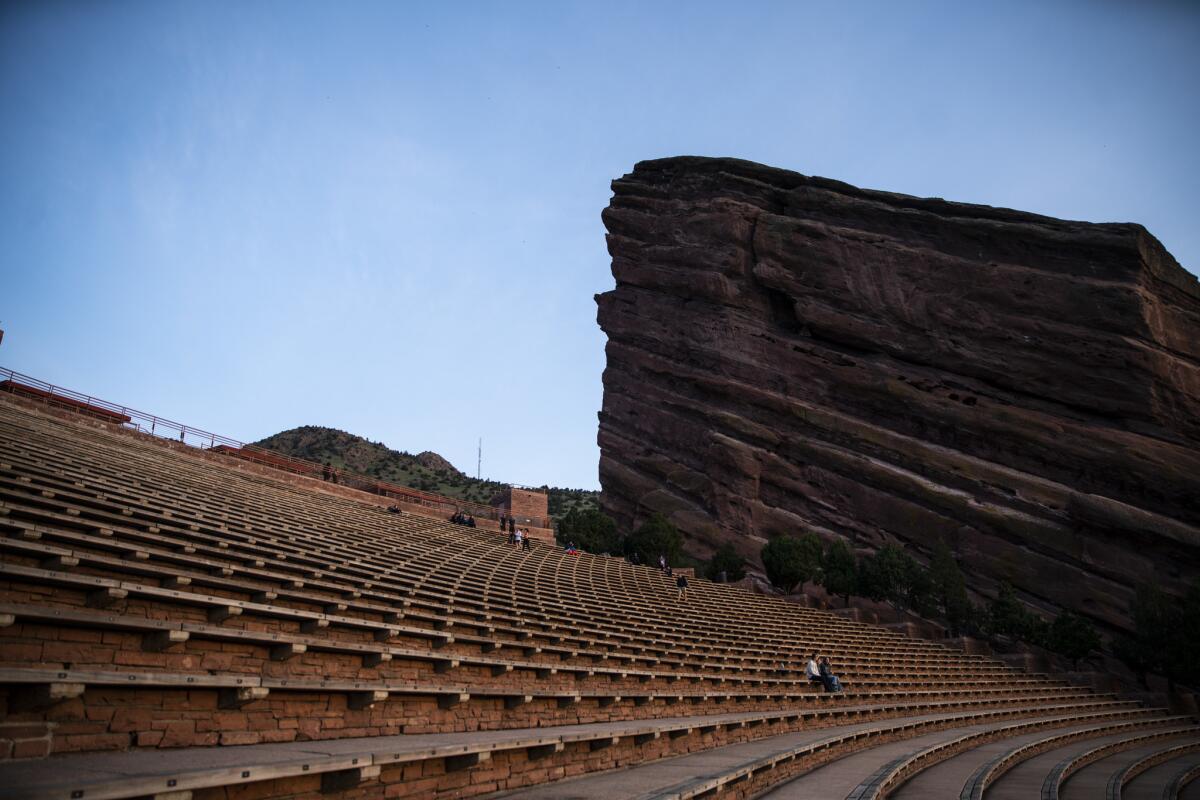
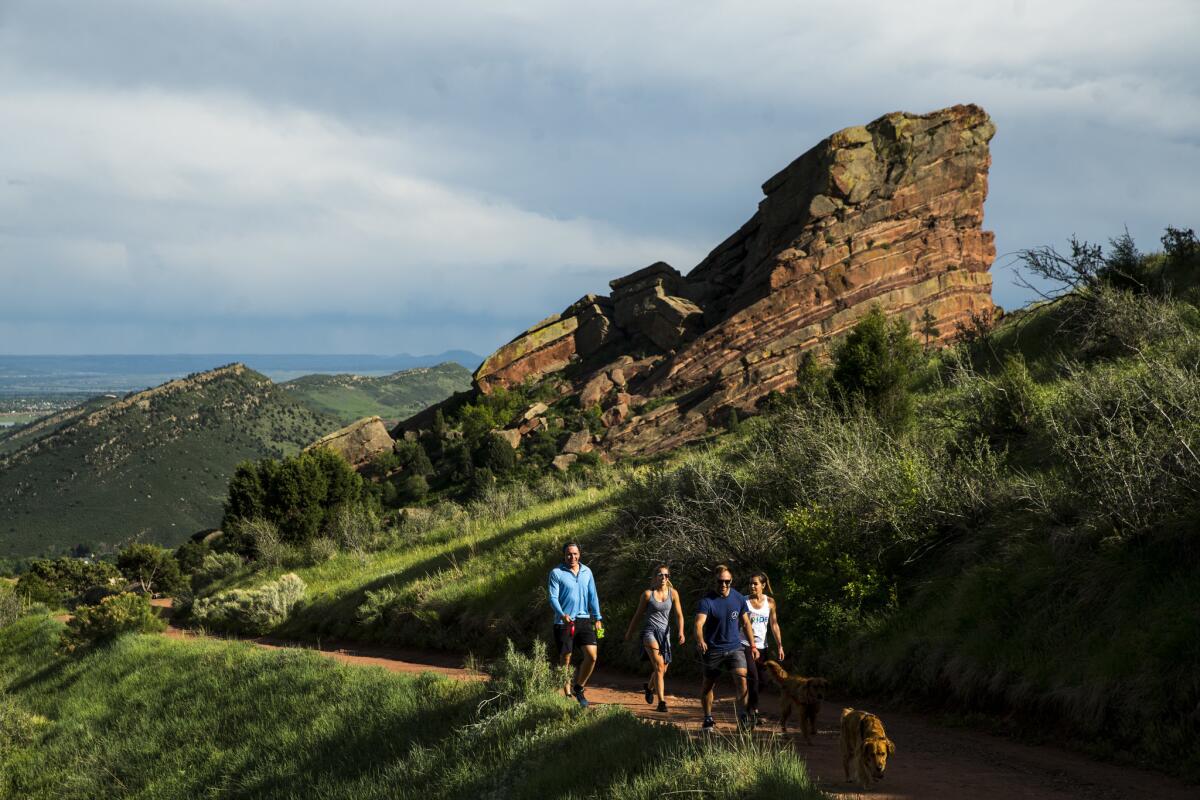
On show days — which is almost every day in summer— the venue closes to visitors in early afternoon. But the trails stay busy, especially the Trading Post Trail.
That route covers 1.4 mostly flat miles through foliage and around rock formations. I encountered no critters on the path in the middle of a spring weekday, but I had plenty of human company, including Jennifer Forsha, a Littleton, Colo., resident who hikes the rocks almost every weekend with her husband and two kids.
“We run up the trail and we run up the amphitheater,” she said. “You see all this beautiful stuff. And if you go up to the amphitheater, it’s a bunch of amazing energy.… It’s my happy place.”
We’ll never know who first made music among the boulders. But historians say the site was a longtime gathering point for native people. And we know that by 1906, a promoter named John Brisben Walker had bought the property, named it the Garden of the Titans and set up a wooden platform.
If you go up to the amphitheater, it’s a bunch of amazing energy.… It’s my happy place.”
— Jennifer Forsha
Pietro Satriano and his 25-piece brass band played that May. Five years later, soprano Mary Garden sang opera.
In years to follow, Walker staged all sorts of events in the area and built a funicular railway, later scrapped.
The city of Denver acquired the amphitheater site in 1927, and architect Burnham Hoyt came up with the plans. Civilian Conservation Corps workers, grateful for work in the middle of the Great Depression, started swinging picks and shovels in 1936 or 1937, often earning $1 per day.
By 1941, the workers had sculpted the space between Ship and Creation rocks into 70 rows for wooden benches, the aisles flanked by juniper trees. Then, as now, there was room for about 9,500 people.
The visitor center, open to concertgoers and sightseers alike, was added in 2007. There’s room for the Ship Rock Grille and a Red Rocks artists’ hall of fame. There’s also a Colorado Music Hall of Fame in the Trading Post building, with a bronze statue in front of — did you guess it? — John Denver.
Meanwhile, performers enjoy dressing rooms built around rock formations. In the tunnel between the sound-mixing board and backstage, generations of musicians have made their marks. (Styx, it seems, travels with a stencil.)
Through the early 1950s, the schedule was short and dominated by classical music, opera and ballet, with each season opened by an Easter sunrise service.
Then pop culture crept in.
By the late 1950s, Jerry Lewis was doing stand-up, Ella Fitzgerald was scat-singing and Ricky Nelson was playing. Ray Charles appeared in 1962 but did such a short, slapdash show that the audience pelted the stage with beer cans and management briefly imposed an alcohol ban.
The Beatles played in 1964 (leaving about 2,500 tickets unsold at $6.60 each). Jimi Hendrix came in 1968. When Jethro Tull appeared in 1971, legions of ticket-less fans tried to breach a fence, security forces let loose with tear gas and a five-year rock ’n’ roll ban began.
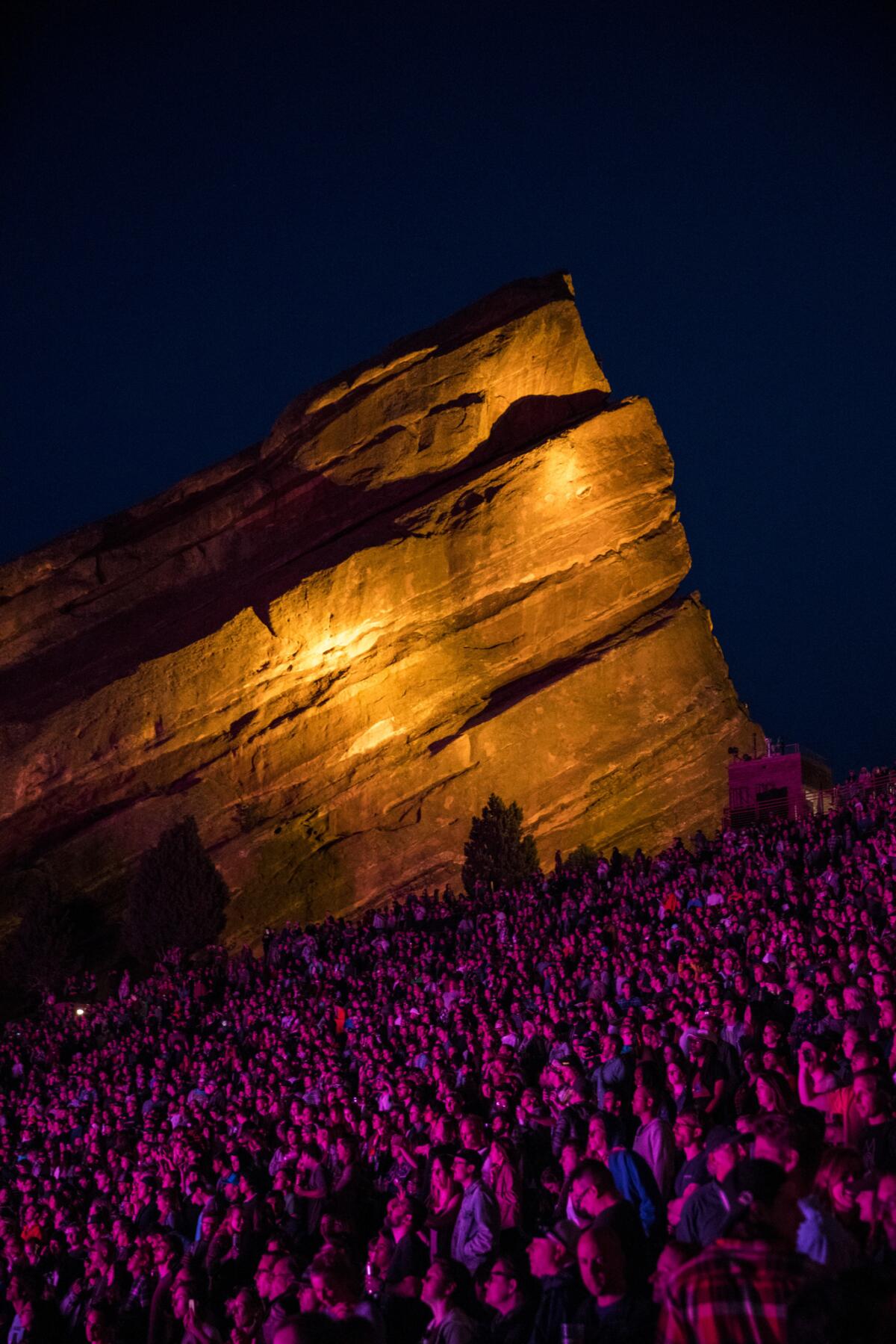
By the late ’70s, the amphitheater was again busy with rock and just about every other genre. In 1978 Steve Martin brought down the house with “King Tut,” a performance audible on his album “A Wild and Crazy Guy.”
Five years later, a young U2 played amid fog and rain, a show featured in the film “U2 Live at Red Rocks: Under a Blood Red Sky.”
Ani DiFranco has sung about reproductive freedom here, John Tesh about God. The Moody Blues crooned “Nights in White Satin” with the Colorado Symphony providing full orchestral pomp. On April 20, 2014, Red Rocks began its day with an Easter sunrise service and ended with a Snoop Dogg show.
“I did 37 shows last year,” usher Ben Miller, 33, told me one night. “Every show definitely does have a different energy to it.” His favorite performance: the alternative band Gorillaz last September.
“It was raining most of the time, but sometimes that makes a better show,” Miller said.
If you sit in Row 33 or higher, you can see the horizon beyond the stage, but it sometimes gets windy. Lightning or hail occasionally forces a delay or cancellation. And because the stage is about 6,450 feet above sea level, performers sometimes come up short of breath. The crew keeps oxygen canisters backstage.
High-energy music
Don’t miss the year-by-year timeline of performers when you browse the visitor center. You’ll notice that the venue gets busier as the economy booms and slower when it slumps (the early 1990s and late 2000s, for instance). As recently as 2012, the Red Rocks performance year included just 78 concerts.
But it’s booming now, with 161 nights booked for this year— including about 30 nights of EDM — electronic dance music. Just as jam bands such as the Grateful Dead, Blues Traveler and Widespread Panic played a key role at Red Rocks in the ’90s and ’00s, EDM shows have multiplied lately. In fact, those shows’ thundering bass lines have prompted new volume limits.
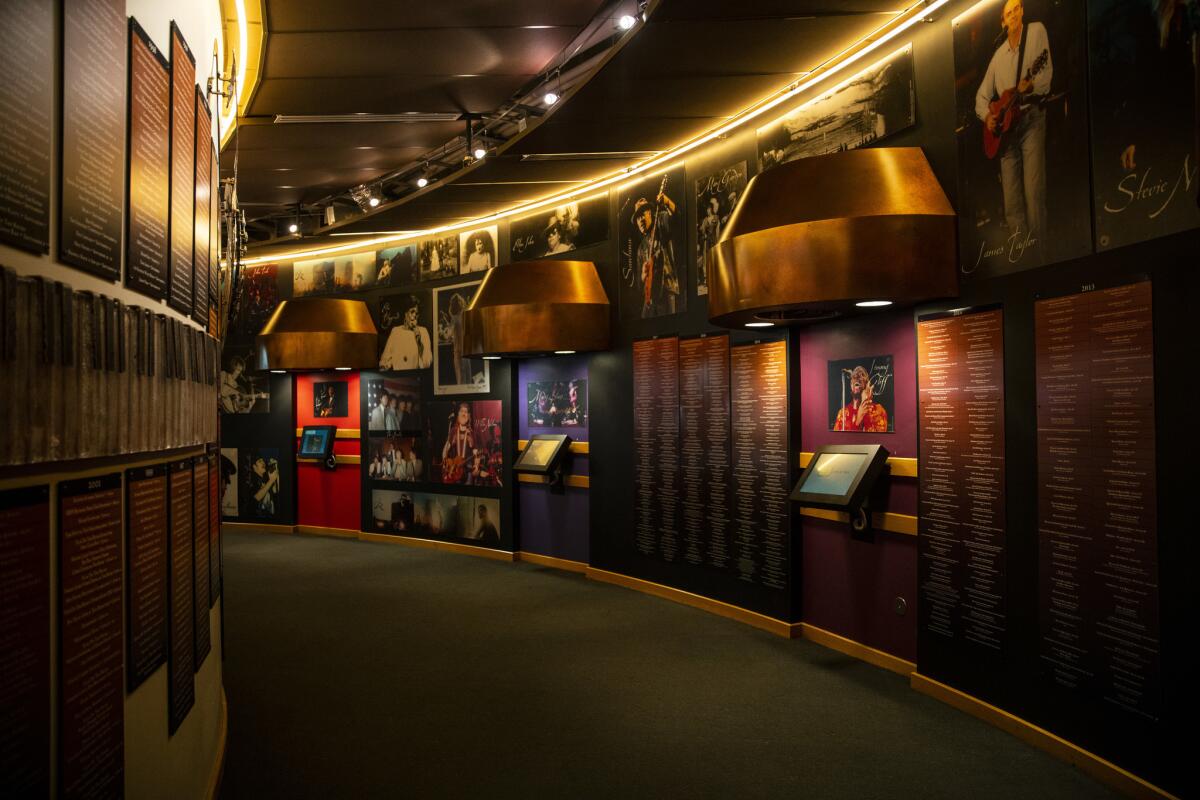
“The crowd is very high energy,” Miller told me. “There’s a lot of drug use.”
When I asked Red Rocks spokesman Brian Kitts about that, he suggested that every new generation of pop music seems to provoke a similar set of complaints. In the larger picture, he said, “I have a hard time believing that having EDM is any different than having Metallica on stage.”
Just my luck — I missed EDM and Metallica. But I did catch Phantogram, a rock band that favors electronica, often slips into spacey dance grooves and uses lots of light effects and projections. In short, this was a marijuana-friendly band. (Though weed is banned from the amphitheater, enforcement is imperfect.) The house was packed, happy and mostly younger than 30.
There are very few places to play in the world that still make me nervous, and this is one of them.”
— Colin Meloy
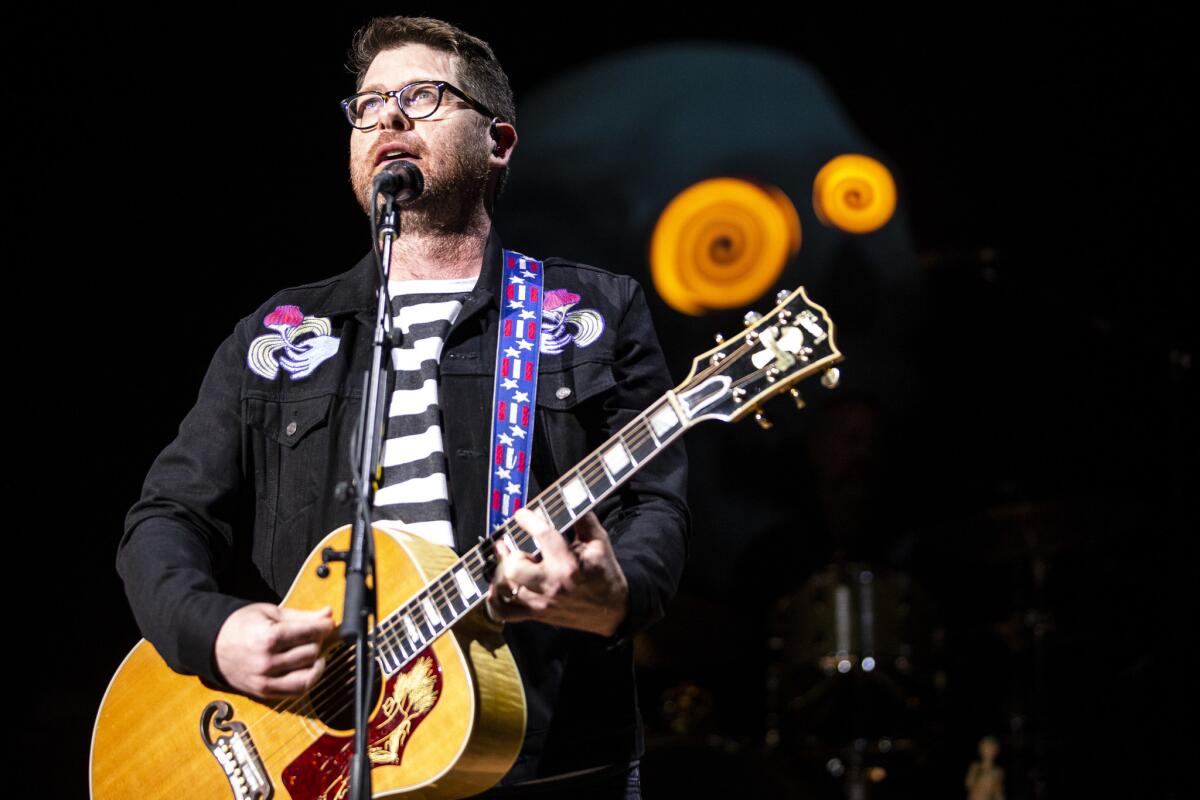
I returned the next night for the Decemberists. It was a smaller crowd, mostly older than 30 and many older than 50, like me. But from the opening notes of “Everything Is Awful” — the band’s first song — it was a happy night.
I joined in when the audience rose and started calling for an encore. For a long neo-tribal moment we all stood clapping, glancing at each other, the boulders and the sky.
Then the band was back, dragging a mysterious canister. Meloy pointed at it. “We’ve got enough oxygen for one more!” he shouted.
Near Red Rocks
Stroll tiny downtown Morrison (population about 430), which lies two miles southeast of the Red Rocks Amphitheatre. Have a look at Bear Creek, see the old white Morrison Chapel and browse the shops along Bear Creek Avenue, the main street.
Try breakfast or lunch at the Cow an Eatery. Before you head to a show at Red Rocks, maybe have a game dinner at the Fort.
Also, stop in at the Buffalo Bill Museum & Grave on Lookout Mountain, which celebrates the life and times of outdoorsman and showman Buffalo Bill Cody (1846-1917). The museum features Wild West show posters and artifacts. As for the gift shop— you’ve never seen so many refrigerator magnets.
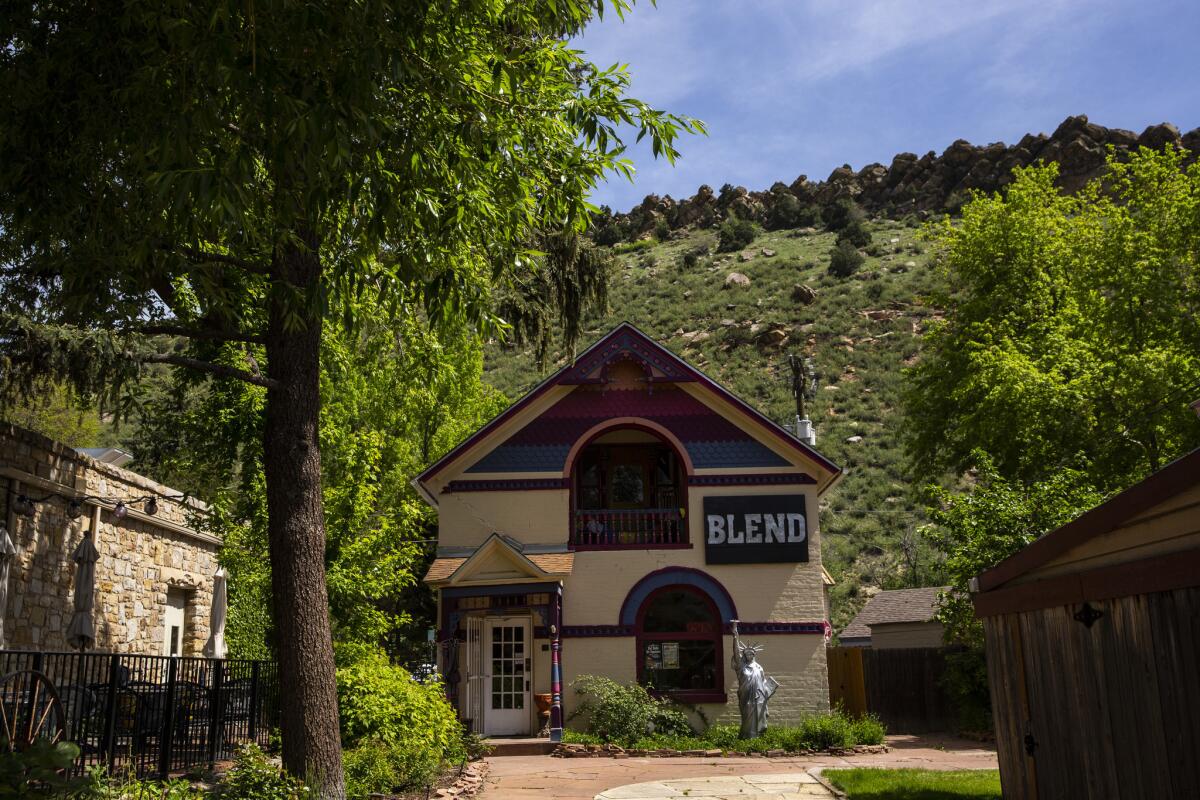
Golden, 8 miles north of the amphitheater, is another worthwhile town near Red Rocks. It’s best known for the Coors Brewery, and, yes, there are tours.
But you may prefer to walk Washington Street and admire the “Howdy Folks!” sign overhead. Check out the path along Clear Creek, where there are often kayakers. Try the pizza at Woody’s Wood-Fired Pizza. If you like, eat it at a picnic table on the bridge over Clear Creek.
The Origin Hotel is supposed to open by the end of the summer. Rates start at $212, dipping to $169 in November. (It was still a construction site when I visited.)
If you go
THE BEST WAY TO DENVER
From LAX, American, United, Delta, Alaska, Frontier and Southwest offer nonstop service to Denver, and American, Delta, United, Southwest and Alaska offer connecting service (change of planes). Restricted round-trip airfare from $151, including taxes and fees.
WHERE TO EAT
The Cow an Eatery, 316 Bear Creek Ave., Morrison, Colo.; (303) 697-5721. This casual place has a pleasant patio and is popular for breakfast and lunch. Most main dishes $8-$15.
The Fort, 19192 Highway 8, Morrison; Colo.; (303) 697-4771. It’s a re-creation of an early 19th century fort. Most steaks cost $40-$64. Bison, beef and quail are specialties. (I had the bison sirloin fixed-price combo with potatoes, greens and quail for $39.) Nice views and fire pits on the patio.
Woody’s Wood-fired Pizza, 1305 Washington Ave., Golden, Colo.; (303) 277-0443. Good pizza, festive atmosphere, and a novelty: Diners are encouraged to pour a dollop of local honey on their crusts. Most pizzas $12-$23.
WHERE TO STAY
The Crawford Hotel, Union Station, 1701 Wynkoop St., Denver; (720) 460-3700. Opened in 2014. This 112-room hotel was created using office and attic space within the city’s historic train station. Doubles from $361, plus $20 nightly “destination amenity fee.”
Courtyard Denver West/Golden, 14700 W. 6th Ave. Frontage Road, Golden, Colo.; (303) 271-0776. Doubles from $130 in summer months.
Cliff House Lodge B&B, 121 Stone St., Morrison, Colo.; (303) 697-9732. A rustic, casual compound that includes one 1873 building. Nine rooms in eight cottages, some with kitchenettes, fireplaces and whirlpool tubs. Rates $200-$390.
TO LEARN MORE
Red Rocks Amphitheatre. The Red Rocks Visitor Center is open 8 a.m.-2 p.m. on event days, otherwise 7 a.m.-7 p.m. April through October, 8 a.m.-4 p.m. November through March. The venue offers private tours ([303] 697-4939, Ext. 108) for groups of 10 or more. For details on open and closing times: (720) 865-2494.
Follow Reynolds on Twitter: @MrCSReynolds
Sign up for The Wild
We’ll help you find the best places to hike, bike and run, as well as the perfect silent spots for meditation and yoga.
You may occasionally receive promotional content from the Los Angeles Times.




